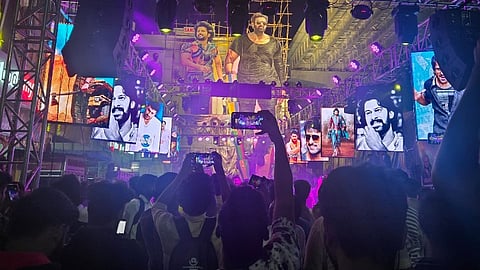

One of the cornerstones of modern Telugu culture is cinema. For us Telugus, cinema is beyond just entertainment — we treat it as part of our cultural identity. We take a lot of pride in our movies and movie industry, Tollywood, and naturally, mould our lives around it.
With every movie, every line of dialogue, every song, and every comedic gag etched into our collective psyche, Telugu people are as much living ambassadors and champions of Telugu cinema as we are fans.
Fiercely loyal, we waste no opportunity to showcase our love for mana (‘our’ in Telugu) cinema. Some of us rally behind our biggest actors and stars in the form of fan associations, drumming up hype for their releases. Perhaps, the biggest manifestation of this love and loyalty can be seen in our First Day, First Show (FDFS) culture.
The First Show of any movie is the first time a new movie is screened for the audience. Catching an FDFS show means watching a movie the minute it hits the screens — typically the midnight or early morning screening on the day of release, usually on a Friday.
FDFS is an important event for both the industry and fans. The opening show is crucial for a film's box office performance, as a strong opening can generate positive word-of-mouth that can boost a movie's long-term success.
For fans and casual moviegoers alike, the FDFS is nothing short of a festival, complete with massive cutouts, fireworks, drum bands, confetti, garlands, and a ceremonial paalaabhishekam (worship with milk) of the movie stars.
Allu Arjun, Mahesh Babu, Pawan Kalyan, NTR Junior, Prabhas — you name the star; the hype for their releases is the same.
Fans often queue for hours, and sometimes even days, to secure the best seats. The first roar of fanfare of seeing our favourite heroes appear on the screens, accompanied by confetti, whistles and chants, sets the tone for the rest of the movie’s run at the box office.
Single-screen theatres in the Telugu states, such as Sandhya 70mm in Hyderabad, Devi 70mm in Vijayawada, and Sree Leela Mahal in Visakhapatnam, bear witness to these expressions of loyalty.
While die-hard fans are most vocal, we casual viewers also allow ourselves to get carried away by this collective euphoria, united by the love for our movies and basking in the glory of our stars.
The origins of FDFS culture
Even as Telugu cinema started as early as the 1910s, and Telugu cinema in the 1970s saw the rise of larger-than-life megastars like NT Rama Rao (NTR) and Akkineni Nageswara Rao (ANR), FDFS culture as we now know it wouldn’t take shape until the 1980s, with the rise of Chiranjeevi and Balakrishna.
Chiranjeevi’s meteoric popularity, in particular, created fan associations across the then-United Andhra Pradesh. Each club was responsible for putting up banners, organising garlands and paalabhishekhams, and ensuring maximum attendance on the release day of his movies.
These traditions would be carried forward to the next generations, as newer heroes arose — such as Venkatesh and Nagarjuna in the 90s, and Allu Arjun, NTR Jr, Mahesh Babu, and Prabhas in the 2000s.
By the 2010s, social media amplified the FDFS craze, giving it a pan-India and even a global reach. Fan associations began trending hashtags, sharing reaction videos, and organising benefit shows worldwide. With the success of the Baahubali duology and RRR, the ritual went international, with the same energy lighting up movie theatres and cinema houses from Hyderabad to Houston.
Even with single screens slowly being replaced by multiplexes, and movies’ runs being cut to size by streaming, the significance of the FDFS phenomenon would not fade. The aforementioned Sandhya 70mm, Devi, and Shree Leela Mahal stand as the last bastions for these expressions of fandom.
A double-edged sword
As mentioned earlier, the FDFS phenomenon is the most prominent manifestation of our love towards our cinema. However, this means that it is also a manifestation of the worst aspects of Tollywood fandom.
With fans clamouring outside theatres for celebrations or even to get tickets, there have been several reports of scuffles and overcrowding, with fans sustaining injuries and even losing their lives. The death of Revathi, a 35-year-old woman who lost her life in the Pushpa 2: The Rule stampede incident at Sandhya 70mm, is still fresh in our minds.
FDFS culture has also become a battleground for rival fan associations to clash and engage in verbal and even physical violence, often escalating harmless excitement into trolling and threats.
While it is an event where we show support to our stars, opening days are also when unbridled, unquestioning and borderline servile devotion of a loud minority of fans manifests itself.
These fans, who proudly call themselves “TFI kattu baanisalu” (Telugu Film Industry’s bonded slaves) devote their lives to these stars in increasingly bizarre ways.
For instance, one fan in Ananthapur, AP, "worshipped" a cutout of NTR Jr with goat blood during the release of his recent movie, Devara, sparking criticism from animal rights.
In this vein, FDFS becomes more about celebrating our stars, with cinema taking a backseat.
However, several notable actors from the industry, like Chiranjeevi and producers like Dil Raju, as well as more reasonable fans, have called out these aspects.
In addition, both the governments of Telangana and Andhra Pradesh have introduced strict measures, such as limiting the number of shows per day, restricting early morning and late night shows, and prohibiting benefit shows to enable better crowd management.
We have a great tradition of celebrating our cinema, and supporting our stars. Therefore it is also up to us to ensure that we do not go overboard, and let common sense prevail.
